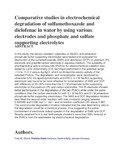| dc.contributor.author | Sifuna, Fred W. | |
| dc.contributor.author | Orata, Francis | |
| dc.contributor.author | Okello, Veronica | |
| dc.contributor.author | Kimosop, Selly Jemutai | |
| dc.date.accessioned | 2021-06-09T07:09:43Z | |
| dc.date.available | 2021-06-09T07:09:43Z | |
| dc.date.issued | 2016-06-23 | |
| dc.identifier.uri | https://doi.org/10.1080/10934529.2016.1191814 | |
| dc.identifier.uri | https://www.tandfonline.com/doi/full/10.1080/10934529.2016.1191814 | |
| dc.identifier.uri | http://r-library.mmust.ac.ke/123456789/1654 | |
| dc.description.abstract | In this study, the electro-oxidation capacities of Na2SO4 and potassium phosphate buffer supporting electrolytes were tested and compared for destruction of the sulfamethoxazole (SMX) and diclofenac (DCF) on platinum (Pt) electrode and graphite carbon electrode in aqueous medium. The suitability of pharmaceutical active compounds (PhACs) for electrochemical oxidation was tested by cyclic voltammetry (CV) technique performed in the potential range −1.5 to +1.5 V versus Ag/AgCl, which confirmed the electro-activity of the selected PhACs. The degradation and mineralization were monitored by ultraviolet (UV)-Vis spectrophotometry and HPLC. 0.1 M Na2SO4 supporting electrolyte was found to be more effective for mineralization of SMX and DCF, with efficiency of 15–30% more than the 0.1 M phosphate buffer supporting electrolyte on the platinum (Pt) and carbon electrodes. The Pt electrode showed better performance in the degradation of the two PhACs while under the same conditions than the carbon electrode for both 0.1 M Na2SO4 and 0.1 M potassium phosphate buffer supporting electrolytes. The SMX and DCF degradation kinetics best fitted the second-order reaction, with rate constants ranging between 0.000389 and 0.006 mol2 L−2 min−1 and correlation coefficient (R2) above 0.987. The second-order degradation kinetics indicated that the rate-determining step in the degradation could be a chemical process, thus suggesting the active involvement of electrolyte radical species in the degradation of SMX and DCF. Results obtained from a real field sample showed a more than 98% removal of the PhACs from the wastewater by electrochemical degradation | en_US |
| dc.language.iso | en | en_US |
| dc.publisher | Journal of Environmental Science and Health, Part A | en_US |
| dc.subject | Comparative, studies, electrochemical, degradation, sulfamethoxazole, diclofenac, water, electrodes, phosphate, sulfate, supporting, electrolytes | en_US |
| dc.title | Comparative studies in electrochemical degradation of sulfamethoxazole and diclofenac in water by using various electrodes and phosphate and sulfate supporting electrolytes | en_US |
| dc.type | Article | en_US |

